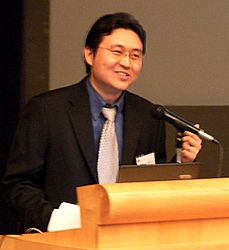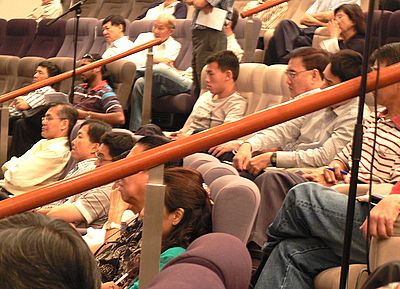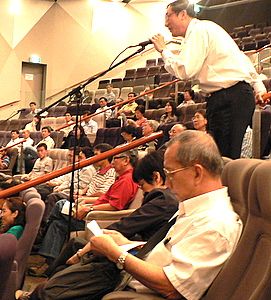
STOCKS HAVE surprisingly soared, and long-suffering investors are feeling relieved - as well as anxious. Will the green shoots of economic recovery wither?
SIAS Research organized a seminar on Thursday night (May 7) at the HDB Auditorium in Toa Payoh to share insights into why the market has rebounded and where it might be headed. SIAS Research vice-president Roger Tan spoke.
Ken Tai, a senior market strategist from Kim Eng Securities, dealt with the topic: Where to go in May?
Stephen Lai, formerly a fund manager and now CEO of NextVIEW, gave his perspective on how the economic situation has changed the marketplace for companies, including his.
Finally, Sean Lee, the CEO of Marco Polo Marine who raised eyebrows because of his relative youth (31 years of age), spoke about his company’s business – and why it has been insulated from the economic storm.
Here is a selection of the questions and answers that came after the four speakers' presentations:
Q: Stephen, you go to China frequently. Do you see green shoots of recovery?
Stephen Lai: I’m a China bull. I see the airports in China are busy. I feel the enthusiasm there, there is a lot of business activity, a lot of consumerism. It’s quite positive. Things are the opposite in the US. The country is going through a very tough time. My friends there tell me the US$1 burger is back. I used to eat US$1 burgers when I studied there many years ago.

Q: Corporate earnings are not very visible but the market has been shooting up. What’s your view on this?
Roger Tan: From a fundamental view, there are signs that the economy would bottom this year and the market is pricing in an economic recovery this year.
But there are still a lot of unknowns and dangers – such as the fate of the US auto companies and credit default swaps.
Ken Tai: As the market is pricing in an economic recovery, my take is that over the next few months, the market cannot afford to have any negative news.
Q: Is the market overbought from a technical point of view?

Ken: Regardless of the indicator you choose, the market is overbought. But the trend is your friend. Technically, at this moment, the market is on a long-term uptrend.
If broking houses start to ask investors to put down money before they can trade, it’s a danger sign – then you should get ready to go the other way.
Q: Stephen Lai, you said ETFs are highly under-rated. Can you elaborate on that?
Stephen: Let’s say you want to buy a China fund. You want to pay up to 5% in sales charge? If you want to invest in China or India or gold, you can buy ETFs on SGX at a much lower fee.
The market maker is obliged to give you a price – you won’t have a situation where there is no price quoted. You can build your investment portfolio on ETFs.
Roger: Let me add that the transaction fee for mutual funds is 3.5-5%. Then you also pay 1.25-2.25% a year to the fund manager. They are so expensive because they claim they can beat the index. On the other hand, the transaction fee for ETFs is what you pay to your stock broker. The management fee is only 0.4-0.6% a year.
Q: For Sean: How often does an AHTS need to be repaired? You referred to it being mandatory to send a vessel for maintenance. Are the relevant bodies able to enforce the law on seaworthiness of a vessel?
Sean Lee: For any vessel, there is a mandatory docking. Typically for the first five years, we have a first docking. Subsequently, every five years there are at least two dockings that you need to do. And this is enforced, depending on which classification society you are in. You need to do your survey and your dockings.

Q: Take a China ETF: The companies that such an ETF owns – vis-à-vis the S-chips. What is your view on the merits of a China ETF?
Roger: China is trying to reform its economy to move away from being export-oriented to being more domestic driven. It will take time for that to happen. If they can achieve it, and export demand also picks up, you are talking about a good growth story for China again.
The S-chips have a governance issue. The other day, my finger was on the ‘buy’ button, but I hesitated and then pulled back. The stock has gone up ... but we are all super smart on hindsight.
We are now unsure about S-chips and we have seen that when they get into trouble, their CEOs are in China – which is outside of Singapore jurisdiction and they walk freely on the streets.
In our SIAS Research report, we recommended going into the HSCI ETF. Lyxor buys the underlying stocks of the ETF. Now, as HSCI is listed in Hong Kong, if anything happens, the law there allows them to go after the CEOs. Secondly, the HSCI is made up of pretty strong companies listed in Hong Kong. So the ETF makes it easy for you to invest from a governance point of view and you don’t have to select individual stocks to gain exposure to the growth in the Chinese economy.

Q: What is the trend for the next six months for the charter rates for tugs and boats?
What factors could cause a change in this trend?
Sean: It’s pretty stable now. The demand for tugs and boats is as high as during the boom time. It’s a phenomenal thing that is happening at the moment. I’m shocked too.
When I saw the Baltic Dry Index come down, I was quite worried. But it turned out that the tugs and barges sector is a little different from the rest.
We have to thank the Singapore government for its $20.5 billion stimulus programme. A lot of construction work has been brought forward, which means a lot of construction materials have to be brought here. They have to be carried by tugs and barges.
For Roger Tan's presentation slides and for information on upcoming seminars, go to www.siasresearch.com.







